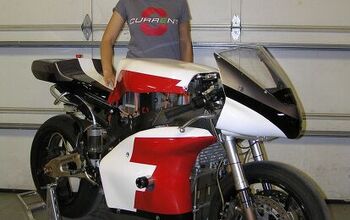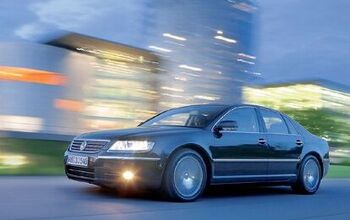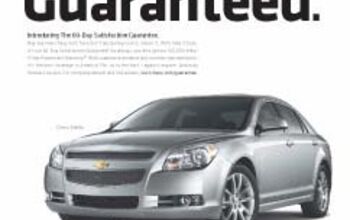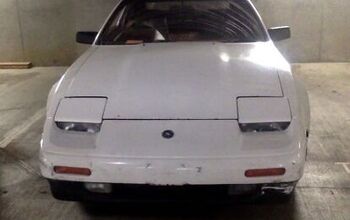Editorial: The Truth About Saturn

When I went car shopping in the early ‘90s, my priorities were fun-to-drive, reliability, and economy. Style— not so much, or so I thought. But the first time I saw a Saturn, I knew instantly what it was, although I’d never seen a photo, since the car was conspicuously absent from the ads. As soon as Consumer Reports gave Saturn a preliminary blessing for reliability, I gave it my consideration. Ultimately, I became so smitten that I didn’t bother to re-look at the Integra after I discovered to my great chagrin, in the dealer’s lot, that the turning circle was nearly as big as the namesake planet’s diameter.
Nonetheless, my Saturn, a ’93 SL2 5-speed, was a hoot to drive. Once a honking Nissan SUV tried to pace me on Cape Cod’s exceptionally scenic and winding Old County Road. He could catch me on the straights, but I lost him easily in the twisties. The Saturn steered precisely and cornered flat with virtually no understeer, aided by its low mass, less than 2500 lbs. Like the vorpal sword in Jabberwocky, the switchgear went snickersnack. The gas mileage: 35 on the road. Although a google search failed to find the quote, some reviewer, somewhere, I swear, had dubbed Saturn “the practical person’s sporty car.”
Yet, within a few years, when people asked me what I drove, I found myself apologizing for the bland… uh, brand. The first time I saw generation-2, I didn’t know whether I was looking at a Hyundai, a Tercel or an Olds. In the same way that peoples’ faces lose definition as the high cheekbones and clear jaw lines of youth disappear under the sagging skin of old age, so the Saturn’s appearance lost its sporty edge.
So did the driving dynamics. On my first drive, on a moderately hard turn which my Saturn would have taken with aplomb, the car leaned way over, and the rear let go.
What happened? My theory was that after the quasi-independent Saturn Corp. was yanked back into the Mother Company in 1994, there had been a turf war between Saturn on Pontiac over which would be the “sporty” division, a status Pontiac had claimed since the first GTO. The evidence: the ‘96 Pontiac Sunfire looked exactly like they’d taken the first gen Saturn, and tweaked the lights.
Dick Danjin, who did two stints as UAW rep in charge at Spring Hill, tells me the problem was far more general (no pun intended). In the vision of GM president Roger Smith, Saturn was to take over where NUMMI left off, teaching old, sclerotic GM all the new Japanese tricks. Collaboration rather than conflict would characterize labor-management relations. This meant, among other things, that the cars would come off of the line properly assembled (a.k.a. “first time quality”) instead of post-assembly fixes, as was the norm on Big 3 assembly lines.
According to “Comeback: The Fall & Rise of the American Automobile Industry,” GM’s $3.5b Saturn investment made it the object of jealousy among the other divisions. Indeed, the autocratic Smith had practically forced Saturn down GM’s intake manifold. With Smith’s departure in 1990, soon after launch, Saturn lost its patron.
But even during pre-launch, Smith couldn’t keep the bean counters from nickel and diming Saturn. Even after suppliers had been vetted and given contracts, accounting would enlist new ones in their quest to shave pennies per car, and quality would suffer, says Danjin.
Saturn was launched before it was ready, says Danjin, who adds that he and his original corporate counterpart, Jay Wetzel, the vice president of engineering at Saturn, had protested vainly. Brake discs warped easily, and there was an oil use problem.
Soon after his second Saturn stint began in 1994, Danjin found that first time quality was a pathetic 38.7 percent, and 300 people were working in the post-assembly fix-it shop 20/7. The quest to achieve black ink through high production was forcing levels of overtime that corroded quality. Danjin says his letters to Saturn corporate Kahuna Skip LeFauve, with carbons to his UAW boss Steve Yokich and GM president Jack Smith (no relation to Roger) barely boosted first time quality to a lackluster 51 percent.
Bottom line: its status as corporate stepchild prevented Saturn from receiving sufficient financing to successfully launch a new car company. Once Saturn lost its quasi-independent status, it lost its way. The original Saturn sold a record 286k units in 1994, placing fifth in car sales that year. Twelve years later, five Saturn models, the Aura, Ion, and Sky automobiles, and the Outlook and Vue SUVs sold a combined total of just 240k units.
Hacks blamed the genesis of Saturn’s slide on letting the original style go stale, and lack of other models. But nearly 20 years on, the gen-1 styling still looks fresh. Had Saturn remained true to Roger Smith’s vision: an import fighter with steadily improving quality, technology, and driving dynamics, and had they kept the original’s great looks, I’d still be on Planet Six.

I'm a freelance journalist covering science, medicine, and automobiles.
More by David C. Holzman
Latest Car Reviews
Read moreLatest Product Reviews
Read moreRecent Comments
- Redapple2 I gave up on Honda. My 09 Accord Vs my 03. The 09s- V 6 had a slight shudder when deactivating cylinders. And the 09 did not have the 03 's electro luminescent gages. And the 09 had the most uncomfortable seats. My brother bought his 3rd and last Honda CRV. Brutal seats after 25 minutes. NOW, We are forever Toyota, Lexus, Subaru people now despite HAVING ACCESS TO gm EMPLOYEE DISCOUNT. Despite having access to the gm employee discount. Man, that is a massive statement. Wow that s bad - Under no circumstances will I have that govna crap.
- Redapple2 Front tag obscured. Rear tag - clear and sharp. Huh?
- Redapple2 I can state what NOT to buy. HK. High theft. Insurance. Unrefined NVH. Rapidly degrading interiors. HK? No way !
- Luke42 Serious answer:Now that I DD an EV, buying an EV to replace my wife’s Honda Civic is in the queue. My wife likes her Honda, she likes Apple CarPlay, and she can’t stand Elon Musk - so Tesla starts the competition with two demerit-points and Honda starts the competition with one merit-point.The Honda Prologue looked like a great candidate until Honda announced that the partnership with GM was a one-off thing and that their future EVs would be designed in-house.Now I’m more inclined toward the Blazer EV, the vehicle on which the Prologue is based. The Blazer EV and the Ultium platform won’t be orphaned by GM any time soon. But then I have to convince my wife she would like it better than her Honda Civic, and that’s a heavy lift because she doesn’t have any reason to be dissatisfied with her current car (I take care of all of the ICE-hassles for her).Since my wife’s Honda Civic is holding up well, since she likes the car, and since I take care of most of the drawbacks of drawbacks of ICE ownership for her, there’s no urgency to replace this vehicle.Honestly, if a paid-off Honda Civic is my wife’s automotive hill to die on, that’s a pretty good place to be - even though I personally have to continue dealing the hassles and expenses of ICE ownership on her behalf.My plan is simply to wait-and-see what Honda does next. Maybe they’ll introduce the perfect EV for her one day, and I’ll just go buy it.
- 2ACL I have a soft spot for high-performance, shark-nosed Lancers (I considered the less-potent Ralliart during the period in which I eventually selected my first TL SH-AWD), but it's can be challenging to find a specimen that doesn't exhibit signs of abuse, and while most of the components are sufficiently universal in their function to service without manufacturer support, the SST isn't one of them. The shops that specialize in it are familiar with the failure as described by the seller and thus might be able to fix this one at a substantial savings to replacement. There's only a handful of them in the nation, however. A salvaged unit is another option, but the usual risks are magnified by similar logistical challenges to trying to save the original.I hope this is a case of the seller overvaluing the Evo market rather than still owing or having put the mods on credit. Because the best offer won't be anywhere near the current listing.


































Comments
Join the conversation
I had a 1992 SL2, 5-speed. The transaxle broke with about 6,000 miles on the clock. Dealer replaced it with no hassles, loaner included (unheard of for a domestic, proletariat-class manufacturer at that time.) After that, the car was wonderful; for fit, finish, comfort and handling, dollar-for-dollar it might be the best car I've ever owned. (I currently drive a 2006 CTS, which I would argue is not as well put-together as that Saturn was.) Saturn was GM's last chance, and they screwed it up. A shame, really.
Another necro post on an old Saturn thread. Besides Corvairs, Saturns are near and dear to my heart. I have owned three of them and still have two, including a 20 year old first gen 1993 SW2. Thanks to the polymer body panels, the car still looks good. Not too many Corollas and Civics left around here in the rusty north from that vintage unless they've been imported from the south. The article is pretty good, though I thought the later designs still looked pretty cool, though that of course is subjective. As to handling, the suspension parts for the DOHC S-series Saturns was the same throughout production. The only difference was that tire size changed in the sedans and wagons in the second generation from 195/60x15 to 185/65x15 due to customer preference for a better ride. Handling was probably a little bit worse with those tires, though easily rectifiable by going back to the earlier size (which they continued using in the coupes throughout production). Probably the best article I've found about the demise of Saturn was this one: http://www.forbes.com/2010/03/08/saturn-gm-innovation-leadership-managing-failure.html For those who dis the S-series cars, they were reliable and durable and sold very well. Even in the third generation when the auto mags were carping on GM for rolling out the same basic car from 10 years earlier, the complaints were on panel gaps and "refinement". The car still topped the acceleration in a review by I think it was Car and Driver (where they gave the nod to the Mazda Protoge as the best compact in the group). However, the SL2 had the best acceleration and among the best gas mileage. Not bad for a 10 year old design. Many people have put hundreds of thousands of miles on them. I know of one guy who put over 880,000 miles on a base model SL on the original engine and trans without overhaul before the odometer broke and he's still going. My last Saturn, which I still have is a 2001 LW300 L-series. Nice driving car, and IMHO a very underrated one, but even as a Saturn fan, I knew that that car was really the beginning of the end for Saturn. By that time the UAW partnership was scrapped, the car, though a decent one, was built off an existing GM platform with promises of more of the same, and GM bean counters failed to differentiate the L-series in an overcrowded field of excellent alternatives with established customer bases. Perhaps offering it up in a performance edition with a manual trans with the V6, or a hybrid (the only hybrids around at the time were the butt-ugly first gen Prius and the two-seater Honda Insight) to keep the green crowd paying attention to Saturn. But in the end, Saturn stopped being Saturn and whatever one says of the cars that came later (and many of those cars have their fans), the brand itself became redundant and undifferentiated.